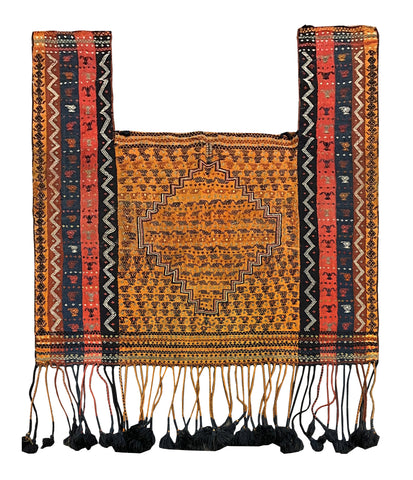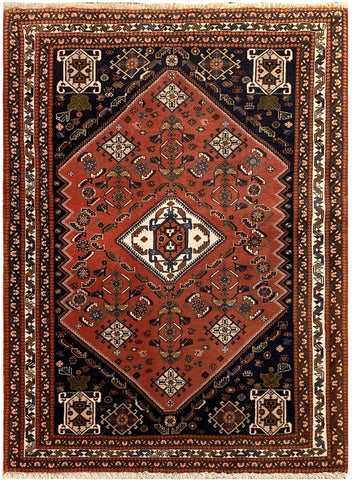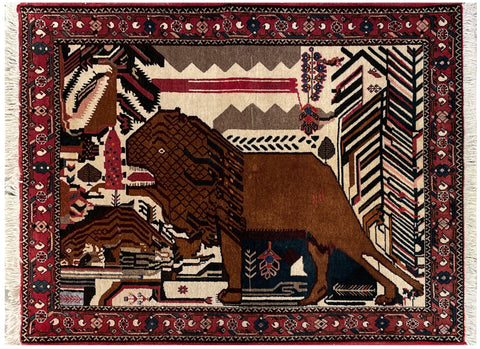24281 - Senneh Hand-Knotted/Handmade Persian Rug/Carpet Traditional/Authentic / Size: 5'3" x 3'9"
Babak's Oriental Carpets
1 in stock
Small Carpet
NR: 24281
Location: Senneh
Size: 5'3" x 3'9"
Country: Iran
Pile: Wool
Base: Cotton
SENNEH
Details:
Sennehs are hand knotted on a vertical loom and use cotton in the warp. The warp threads are fine...
NR: 24281
Location: Senneh
Size: 5'3" x 3'9"
Country: Iran
Pile: Wool
Base: Cotton
SENNEH
Details:
Sennehs are hand knotted on a vertical loom and use cotton in the warp. The warp threads are fine and are tightly spun. In spite of the common use of the term Senneh knot to indicate the Persian knot, it is, in fact, the Turkish knot that is used in Senneh carpets. The number of knots per square inch is medium to high, sometimes reaching up to 500. Kelims are also made in the same designs.
Description:
Despite being hand knotted by Kurdish craftsmen, Sennehs differ substantially from other Kurdistan carpets. Kurdish carpets have a wool weft with deep, irregularly cut pile and primitive designs. It would seem that the very fine work at Senneh came into being when Nadir Shah named Senneh the capital of Kurdistan and sent his Persian dignitaries there. These Persian dignitaries did not think much of the local carpets and therefore ordered the craftsmen of Senneh to make carpets that were significantly finer and used cotton warps. Over the centuries, this fine carpet making tradition was maintained and encouraged.
The designs frequently employ the herati motif (diamond-shaped bands with floral heads both inside and surrounding, often repeated over the entire field of the carpet), as well as the boteh motif (a highly stylized leaf-like floral symbol, similar to a Paisley pattern). If the design incorporates a center medallion, this is distinguished by a different background color (dark blue field, light medallion). The border is also generally decorated with the herati. The boteh are used with more imagination than usual. In some carpets it is arranged in the customary vertical lines, though in this case the boteh is usually rather large (e.g., 8 in.). In other carpets the botehs are arranged in a circle and each one forms the petal of a rose. These roses are repeated to cover the field of the carpet. Another common motif is the gul-i-Mirza Ali (flower of Mirza Ali). This type of Senneh has a herati border and, on the inside, a floral motif. Senneh borders are the traditional three-band type with the central one usually decorated with border herati in an extremely angular form. Border boteh are also quite common, while some specimens have a floral-type decoration enclosed in small cartouches. Sennehs are usually dark, using deep blue and wine colors, but sometimes more brilliant colors of ivory and yellow are used. In any combination, the colors are always pleasing and harmonious.
Unfortunately, few Sennehs are now made and only a limited number of small rugs, and even fewer room-sized carpets, come onto the market. Indian weavers produce copies of traditional Senneh schemes, particularly those based on the herati and medallion-and-corner formats, but these are often rather crude in both color and design.
Price Range and Value:
MEDIUM TO HIGH
The growing scarcity of Sennehs, coupled with the quality of their weave and artistry, makes them very sound investments. This is particularly true of the finer examples.
For any further questions please call us at: (250) 480-7114
Articles and Videos
Related Products
CAD $9,599.00 CAD $2,899.00
CAD $4,599.00 CAD $1,499.00
CAD $2,999.00 CAD $899.00
CAD $1,599.00 CAD $569.00
CAD $1,599.00 CAD $599.00
CAD $2,199.00 CAD $569.00

















